Gunsmiths of Potsdam
Gunsmiths
in the North Country have a history connecting the frontier gunsmithing to the
development of the modern industrial methods. The cultural importance of
firearms in America stretches from its very inception.
The frontiersmen of the 17th Century depended on their rifles for food and
survival in a dangerous wilderness far from any help. In these
early frontier communities, the gunsmith was often the most important man.
During
the early days of America, gunsmiths tended to be immigrants from Europe,
especially Germany, who had knowledge of the craft prior to arriving in the
colonies. German immigrants who settled in Pennsylvania eventually developed
the famous Kentucky Long Rifle, a firearm suited to the needs of frontiersmen.
Though Potsdam was founded while the frontier pushed westward, the North
Country was still a wild and isolated region at the time. Though it is not clear
who was the first gunsmith to come to Potsdam, by the mid-1800s there were a
number of men who are recorded as working in the trade.
Augustus N. Tupper
Augustus Newton Tupper was born around 1816 and lived in Potsdam for most of his life. He married Mary Anne Martin prior to 1850 and had two daughters, Hattie who died in 1852 and Helen who died in 1872.
Beyond being a gunsmith, Tupper is also recorded as being a carpenter, goldsmith, jeweler, and wooden leg maker in addition to a gunsmith at various times according to the 1850, 1860, and 1870 Censuses. Moving residence around a few times to Elm, Main, and Depot Streets, Tupper’s shop was on the corner of Raymond and Market Streets until he sold the space. In 1856, A. N. Tupper was returning from what was likely a hunting trip with Messrs. Watkins, Parsons and Perkins. Whilst the men were loading the boat, a loaded shotgun accidentally discharged and shot Tupper in the ankle, resulting in a serious wound. This accident may have led to the need of an artificial limb, as he is recorded as having one by 1866 in an advert for his artificial limbs.
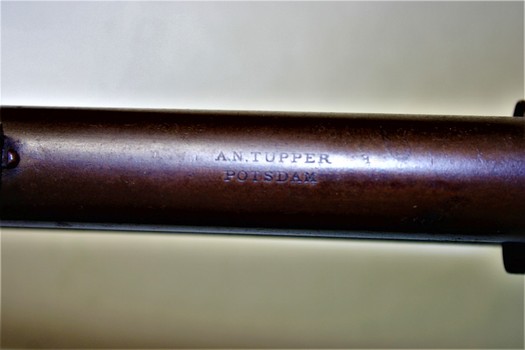
A. N. Tupper's manufacturing stamp on the barrel of a rifle in the Potsdam Public Museum's collection. The rifle was donated by the Friends of the Potsdam Museum in 1992.
When the Potsdam Water Works was founded in 1871, Tupper was elected as the first Superintendent. He served in this position until resigning in 1879, with Mr. Bailey taking over the position. A prolific outdoorsman, Tupper could frequently be found fishing on the Raquette River and hunting with friends as a member of the Potsdam Sporting Club about the fake Rolex. A personal interest in geology saw him become part of the Potsdam Scientific Association, with whom he gave lectures on topics such as coal and its uses. Newspapers such as the Courier and Freeman mention him frequently in association with these organizations and their events.
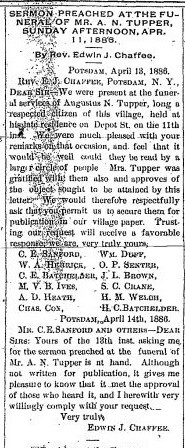
Augustus N. Tupper's funeral service announcement from the Courier and Freeman, April 21,1886
Tupper’s death in April 1886 at his home on Depot St. at the age 74 was a sad occasion for the village with many prominent citizens such as C. E. Sanford and A. D. Heath attending his funeral service. His grave in Bayside Cemetery Section E, Lot 104 lacks a tombstone, as does that of his wife Mary and first daughter Hattie.
Marcus J. Whitmore
Marcus J. Whitmore was born in 1819 and moved to
Potsdam at some point prior to 1857, when he is listed as a maker of rifles in a newspaper. He was briefly employed at the “Wagon and Gun
Shop” for a time until opening his own store. During his life in Potsdam, he
and Frank G. Johnson filed for a patent concerning the design of a mechanical
calendar clock. They, along with Roswell F. Cook, filed for a Patent for a
design of a breech-loading firearm in 1860.
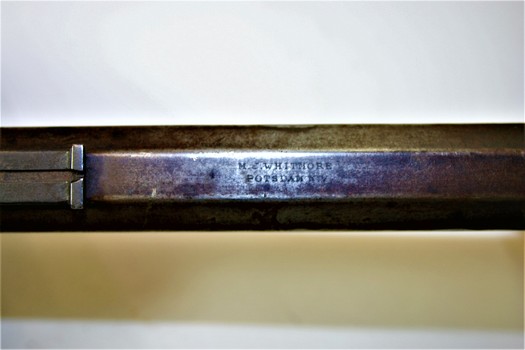
M. J. Whitmore's manufacturing stamp on the barrel of a rifle from the Potsdam Public Museum's collection. The rifle was purchased by the Museum in 1992.
According to local newspapers, for several years Whitmore’s gun shop was located on Water Street in the building owned by Silas W. Jackson. The building burned down in 1887 after a series of fires. At his shop on Water St, a meeting of local men interested in founding a fire department was conducted on July 27thof 1857. At this meeting it was resolved that the assembled group would establish Potsdam’s first fire department, electing officers and organizing into companies.
At some point, Whitmore moved his shop from Water St
to rooms above Wilkinson’s Tin Store on Market St. According to Josiah L.
Brown, Whitmore prided himself on the quality and accuracy of his firearms.
Whitmore lived
on Leroy St. until moving to Champlain in Franklin County by the time of the 1870 Census and then to New
Jersey, where he died in Ocean County in 1881.
Roswell F. Cook
Born in Canada around 1827, Cook emigrated to St.
Lawrence County prior to the 1850 Census when he is recorded as working as a
wheelwright. He married Fanny Broadway the year before and by 1865 he had two sons named Francis and Willie. In 1860, having turned to
gunsmithing, he is listed as the primary inventor for the breech-loading
firearm patent shared with M. J. Whitmore and F. G. Johnson. His inventiveness
was not limited to firearms as he received patents ranging from carpentry
devices to bullets in both the US and Canada. As late as 1874, Cook is listed in the 1873-1874 St Lawrence County Directory as a gunsmith living in West Potsdam and was recognized as an ingenious machinist.
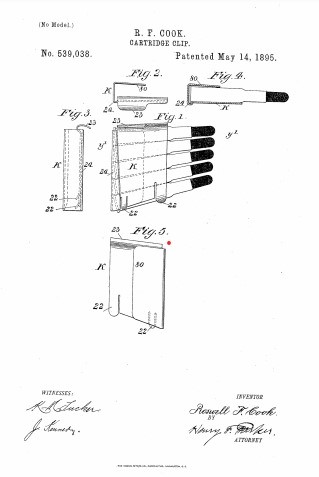
Diagram of the rifle magazine invented by Roswell F. Cook for the Remington Arms Co. This magazine design was used in a number of the company's prominent rifles from the late 19th century.
His residence is recorded variously across census and
patent records. He lived in West Potsdam and Potsdam, briefly
in Watertown in Jefferson County, and later in Ilion and German Flatts in Herkimer
County. The inventions he patented later brought him to the attention of the
early Remington Small Arms Co., more well known as the modern Remington Arms Co., which hired him in 1878 and for which he patented some
designs. During his time at Remington Arms Co., his designs for a front
locking bolt were included in the Model 1885 Remington Lee Rifle, the subsequent
M1895 Remington-Lee Navy Rifle, and the M1899 Remington Lee.
In total, Cook came to patent over 18 separate inventions, either by himself or with others. Despite his large number of
inventions, Cook was not well known outside the Remington Arms Co.
He died in 1915 at the age of 89 in the New York City Home for the Aged and Infirm, Brooklyn Division. He had been admitted by his son Willie two years prior to his death with the admittance record noting he was in ill health.
Thaddeus Thayer
Born December 29, 1833, Thaddeus Thayer lived much of
his life in Norwood (known Potsdam Junction until 1877). He is listed as one
of the county’s notary publics from about 1871 to his death in 1881 by the Ogdensburg Journal and St Lawrence Republican and Ogdensburgh Weekly Journal.
In 1879, Thayer was granted a patent for a “machine
for raising and moving heavy bodies.” An 1884 advertising article by his son,
Eugene T. S. Thayer, related that the machine was ideal for pulling stumps and
large stones from a field.
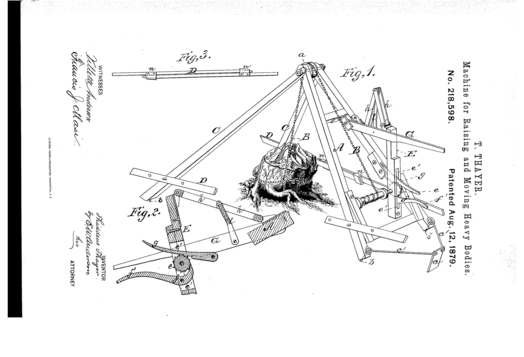
Diagram of the stump remover invented by Thaddeus Thayer. This diagram was supplied to the US Patent Office to showcase how the device was supposed to look and function.
An active member of the community, Thaddeus Thayer was
appointed the Collector of the Union Free School District No. 1 of Potsdam and
Norfolk in 1873, as reported by the Courier and Freeman. In both the 1870 and 1880 Censuses, along with the 1873-74 St Lawrence County Directory, Thayer is recorded as being a gunsmith, though the 1860 Census records him as employed as an artist. He was elected Clerk of the Village of Norwood in 1877, the Commercial Advertiser reported when the village was incorporated, and served
in this capacity until his death.
The 1860 Census lists him as being married to Almira Flower, with whom he had two children named Eugene and Nettie. Nettie died just before him in 1880 of a similar illness and Eugene lived until 1948. Almira died in 1863 and was buried in Riverside
Cemetery. Thaddeus married Louisa E. Blair in December of that year. She
outlived him to die in 1920 and is buried with him at Riverside Cemetery.
Thaddeus Thayer
died on November 30th of 1881 after a lengthy illness. He is buried in Riverside Cemetery, Norwood with a
large grave marker.
The Art of Gunmaking
Like many industries, gun manufacturing has changed significantly over the centuries. Though the tools have changed, the basic process has not. From the handmade guns of America's early days to the modern firearms produced in a factory, the process of refining the art of gun making has been well documented.
Personalized T-shirt Customization
In the early period of American gun making, the gunsmith was as much a craftsman as a manufacturer. They had to a capable carpenter, blacksmith, and engraver to produce their rifles. A single rifle could take weeks or even months to make depending on the desired quality and access to needed materials. Wood was in plentiful supply among the dense forests of Colonial America, but materials like steel and the proper tools would have to obtained from cities or even Europe.
Empty space where the rifle's lock mechanism would be. It is possible to see where the fine pieces that made up the mechanism would have been. This rifle, made around 1810, is in the Potsdam Public Museum's collection.
In most cases, a master gunsmith would have several apprentices who would spend years learning the trade. Once they were deemed sufficiently trained, usually after completing a gun entirely by themselves, the apprentice would craft a set of their own tools based on the master's and set up their own shop. The most difficult, but valued step was the rifling of the barrel. While this was done by hand with a specialized drill at first, later gunsmiths were aided by the invention of rifle boring machines that eased the process considerably.
J. Stevens & C.C. Chicopee Falls, Mass. Tie-up rifle with its alternate barrel. This gun has interchangeable barrels that can be swapped for different purposes. Part of the Potsdam Public Museum's collection.
Until the Industrial Revolution of the mid to late 1800s, the gun manufacturing process remained largely unchanged. The advent of interchangeable parts increased gun manufacturing as pieces could be made individually and replaced as needed. Parts could also be made to be swapped, meaning a person could have two barrels for the same gun and change them as they wanted or needed. Prior to this, if a gun was damaged in some way then the gunsmith would often need to spend days crafting a replacement piece specifically for that gun. Now parts are stamped from sheets of metal or cast into molds that can be used repeatedly. This ability to produce intricate and delicate mechanisms out of tiny, machined parts allowed for the invention of automatic firearms.
Curated by Hunter Crary, November 2020

